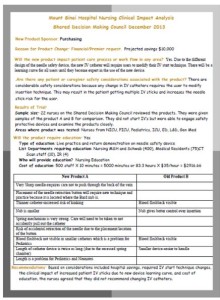Karen E. Bry, RN, BA, CPHQ, System Director for Nursing Education and Professional Practice, Sinai Health System, Chicago Illinois.
Historically the rank and file, front line nursing department staff has had little influence or control over the flow of new products. Decisions are made by purchasing department management in consultation with nursing management. Nursing staff sometimes “trial” new products and are asked their opinion, but there is rarely an appropriate survey instrument upon which to rank or score the opinions, and the impact on nursing process is rarely weighed. Ultimately, nursing’s opinion is one factor in a decision dominated by cost, utilization, and the influence of bundled purchasing agreements.
New VA Model
Value Analysis thought leaders are addressing the need to study the relationship between quality, outcomes, and valued based purchasing. Emerging voices encourage Value Analysis team members to embrace Clinical or Evidence-Based Value Analysis which involves evaluation of the product use before and after implementation to measure the impact on outcomes. The Cost Quality Outcomes model (CQO) stresses the confluence of cost, quality, and outcomes, and the need to embrace all model components equally. Lastly, Value Analysis leaders have come to understand the importance of the “voice of the customer” in preventing expensive utilization misalignments.
The Value Analysis Committee (VAC) at Mount Sinai Hospital in Chicago welcomes nursing involvement. New products are introduced by purchasing personnel, the nursing department, and many different ancillary departments. If the product is thought to have a clinical impact, typically a nursing director will volunteer to trial the product and gather input from the staff. Those involved in the trial use a generic VAC trial review instrument which has a varying degree of ability to capture product or device specific performance. If the product is not thought to have a clinical impact it may be approved without trial. At times it is unclear the degree to which a department will be impacted.
In 2013, several product introductions by ancillary departments resulted in major process flow interruption and an undue burden on the Department of Nursing. Based on those product introductions, a Nursing Clinical Impact Analysis Program was designed. The new process better captures the real impact on nursing and patients by weighing benefit, risk, and true cost as it relates to process change, utilization patterns, and end user educational burden.
The Mount Sinai Hospital Clinical Impact Analysis Program is executed by the Share Decision Making Council Members. Staff nurses on the Council were educated on supply chain fundamentals. In order to answer the first critical question – why the product is changing, the nurses were given education on supply chain fundamentals and an overview of hospital purchasing collaborative ability to reduce operational cost by leveraging negotiation strength.
New VA Impact Process
Our Council members review the old and new products and then use the Clinical Impact Analysis form (Exhibit “A”) to walk through the product reviews. Items under review include:
1. New product sponsor
2. Reason for product change
3. Key stakeholders impacted by product change
4. Will the product come in contact with the patient?
5. Will the new product impact patient care process or work flow in any area?
6. Are there any patient or caregiver safety considerations associated with the product change?
7. Is there a significant difference between the old and new product?
8. Results of the trial
· Sample size
· Area(s) where product was tested/trailed
· Results of trial
· Will the product require education?
· Type of education
· List departments requiring education and the number of staff in each department
· Cost center where training costs may be charged
9. Recommendations
In the example provided (exhibit “A”), 22 highly experienced nurses were given samples of both IV catheter products. They handled the catheters, engaged safety mechanisms, and discussed the pros and cons for the adult and pediatric populations. Careful consideration was given to patient safety and the patient experience. They determined that the cost benefits did not outweigh the risk to the patient due to the projected increase in needle sticks secondary to 500 nurses and physicians learning and mastering a new device technique.
Exhibit “A” Sample Clinical Impact Analysis Form
Conclusion
Findings of the Impact Analysis were presented to the Value Analysis Committee. Based on the recommendations of the Nursing Council the VAC committee did not proceed with the IV catheter change. Nursing and the VAC now collaborate regularly on the review of new products. The Nursing Impact Analysis has strengthened the voice of nursing and afforded the Value Analysis team a strong clinical partner to prevent product misadventures and optimize purchasing quality and outcomes.
Correspondence: Karen E. Bry, RN, BA, CPHQ Mount Sinai Hospital, 15th and California, Chicago, IL 60608 ([email protected])





